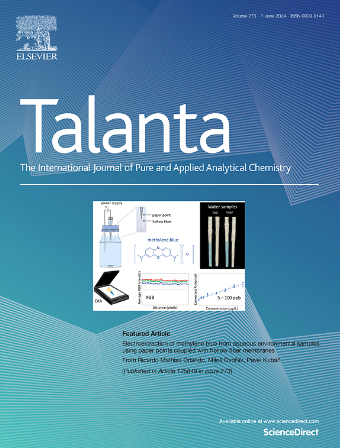A split-type near-infrared photoelectrochemical and colorimetric dual-mode biosensor for the high-performance determination of HepG2 cells
IF 5.6
1区 化学
Q1 CHEMISTRY, ANALYTICAL
引用次数: 0
Abstract
Hepatocellular carcinoma (HCC) stands as a grave illness characterized by elevated death rates. Early identification plays a vital role in improving patient survival. Herein, a novel split-type dual-mode biosensor featuring with near-infrared photoelectronchemical (PEC) and colorimetric sensing characteristics was developed for the high-performance detection of HepG2 cells. Biotin labeled aptamer (Bio-Apt1) was immobilized onto 96-well plates functionalized with streptavidin to capture HepG2 cells through specific binding. HepG2 cells were then labeled with another aptamer (Apt-2) by recognizing GPC3 on the surface of HepG2 cells. Apt 2 could form DNA double strand (dsDNA-ALP) with ALP-labeled complementary DNA (cDNA-ALP). Subsequently, ALP was released to catalyze AAP to form ascorbic acid (AA), and AA reduced HAuCl4 to form gold nanoparticles (AuNPs). Then the mixture containing AuNPs was introduced onto the surface of Y-MOFs/GCE to enhance the photocurrent response. The change of photocurrent corresponding to the concentration of HepG2 cells can be used for the PEC determination. ALP can catalyze the hydrolysis of disodium phenyl phosphate to produce phenol, followed by a reaction with 4-aminoantipyrine and potassium ferricyanide, resulting in a quinone derivative for the colorimetric determination. The photoelectrochemical and colorimetric detection models show excellent selectivity and sensitivity in identifying HepG2 cells, exhibiting a linear reaction range from 1.0 × 102 to 1.0 × 106 cells mL−1 and a detection limit of 13 cells mL−1 and 51 cells mL−1, respectively. The dual-mode split type biosensor avoided direct damage to biomolecules from high-energy light, and the independent signal transduction enabled the acquisition of reliable results.

求助全文
约1分钟内获得全文
求助全文
来源期刊

Talanta
化学-分析化学
CiteScore
12.30
自引率
4.90%
发文量
861
审稿时长
29 days
期刊介绍:
Talanta provides a forum for the publication of original research papers, short communications, and critical reviews in all branches of pure and applied analytical chemistry. Papers are evaluated based on established guidelines, including the fundamental nature of the study, scientific novelty, substantial improvement or advantage over existing technology or methods, and demonstrated analytical applicability. Original research papers on fundamental studies, and on novel sensor and instrumentation developments, are encouraged. Novel or improved applications in areas such as clinical and biological chemistry, environmental analysis, geochemistry, materials science and engineering, and analytical platforms for omics development are welcome.
Analytical performance of methods should be determined, including interference and matrix effects, and methods should be validated by comparison with a standard method, or analysis of a certified reference material. Simple spiking recoveries may not be sufficient. The developed method should especially comprise information on selectivity, sensitivity, detection limits, accuracy, and reliability. However, applying official validation or robustness studies to a routine method or technique does not necessarily constitute novelty. Proper statistical treatment of the data should be provided. Relevant literature should be cited, including related publications by the authors, and authors should discuss how their proposed methodology compares with previously reported methods.
 求助内容:
求助内容: 应助结果提醒方式:
应助结果提醒方式:


